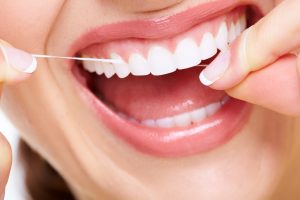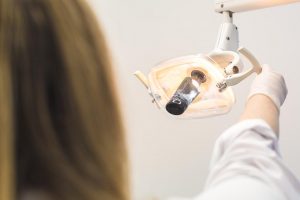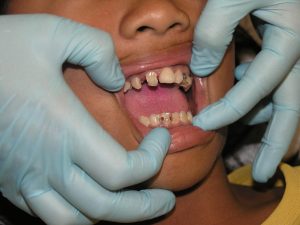
Your dentist will then apply a gentle acidic solution to the surface of the teeth. Similar to the way that roughing up a surface with sandpaper can help paint adhere to it better, acid etching of the tooth surface strengthens the bond of the composite and the adhesive. After 15 seconds the phosphoric acid is removed, and a liquid bonding agent is applied.
For a direct composite restoration:
Your dentist then will place a putty-like composite resin in stages on the natural surface of the tooth, then shape and sculpt it.
A high-intensity curing light will be used to harden that layer of composite, and the previous step will be repeated, then cured, until the filling or direct composite veneer has reached its final shape.
For a restoration from a laboratory:
Your dentist will place the appropriate adhesive into the restoration, seat the restoration on the tooth and light-cure it using a high-intensity curing light for the appropriate amount of time.
If you, your family or friends need dental care, we would be honored to provide you with state-of-the-art dental care in our modern dental practice. Refer someone you love to someone you trust!
Presented as a service to the community by Doctors Hoover and Yanda,
39 Milford Drive, Hudson, Ohio 44236. 330-650-0360. www.drshooverandyanda.com

 The term bonding is used in dentistry to describe adhering dental materials to your teeth using specialized adhesives and a high-intensity curing light.
The term bonding is used in dentistry to describe adhering dental materials to your teeth using specialized adhesives and a high-intensity curing light. To determine if your dental problems can be solved with direct composite bonding, your dentist first will conduct a thorough examination and evaluation of your teeth and gums. During your consultation, your dentist will discuss the clinical and cosmetic problems that direct composite bonding can resolve, such as cavities, chips, cracks, fractures, gaps and spaces between teeth, and tooth discoloration. However, if you have teeth that are extensively damaged or your dentist feels other dental issues may affect the success and longevity of direct composite bonding treatment, other options may be presented to you, such as crowns or veneers.
To determine if your dental problems can be solved with direct composite bonding, your dentist first will conduct a thorough examination and evaluation of your teeth and gums. During your consultation, your dentist will discuss the clinical and cosmetic problems that direct composite bonding can resolve, such as cavities, chips, cracks, fractures, gaps and spaces between teeth, and tooth discoloration. However, if you have teeth that are extensively damaged or your dentist feels other dental issues may affect the success and longevity of direct composite bonding treatment, other options may be presented to you, such as crowns or veneers. Enamel loss is a common component of tooth decay and may result in tooth sensitivity. In many cases, sensitivity caused by enamel loss will be significantly improved or completely eliminated once an appropriate dental filling material is placed.
Enamel loss is a common component of tooth decay and may result in tooth sensitivity. In many cases, sensitivity caused by enamel loss will be significantly improved or completely eliminated once an appropriate dental filling material is placed. Composite fillings are usually more expensive than traditional amalgam fillings because they require a more sophisticated process, more expensive materials and additional office equipment. Composite materials offer an aesthetic alternative to traditional amalgam materials. Because composites can be bonded to teeth, they provide a better seal against leakage and further decay. As such, people who have previously received amalgam fillings often return to their dentist to have them replaced with composite.
Composite fillings are usually more expensive than traditional amalgam fillings because they require a more sophisticated process, more expensive materials and additional office equipment. Composite materials offer an aesthetic alternative to traditional amalgam materials. Because composites can be bonded to teeth, they provide a better seal against leakage and further decay. As such, people who have previously received amalgam fillings often return to their dentist to have them replaced with composite. Composite fillings are usually more expensive than traditional amalgam fillings because they require a more sophisticated process, more expensive materials and additional office equipment. Composite materials offer an aesthetic alternative to traditional amalgam materials. Because composites can be bonded to teeth, they provide a better seal against leakage and further decay. As such, people who have previously received amalgam fillings often return to their dentist to have them replaced with composite.
Composite fillings are usually more expensive than traditional amalgam fillings because they require a more sophisticated process, more expensive materials and additional office equipment. Composite materials offer an aesthetic alternative to traditional amalgam materials. Because composites can be bonded to teeth, they provide a better seal against leakage and further decay. As such, people who have previously received amalgam fillings often return to their dentist to have them replaced with composite. One of the more common oral health issues discovered during scheduled cleanings is dental caries (tooth decay). Your dentist will examine your teeth using a dental instrument called an explorer and may also take an X-ray to determine the extent and exact location of the cavity and decay. In our office, we also use a laser to help detect decay.
One of the more common oral health issues discovered during scheduled cleanings is dental caries (tooth decay). Your dentist will examine your teeth using a dental instrument called an explorer and may also take an X-ray to determine the extent and exact location of the cavity and decay. In our office, we also use a laser to help detect decay. Always ask your dentist if you’re not sure how your nutrition (diet) may affect your oral health. Conditions such as tooth loss, pain or joint dysfunction can impair chewing and are often found in elderly people, those on restrictive diets and those who are undergoing medical treatment. People experiencing these problems may be too isolated or weakened to eat nutritionally balanced meals at a time when it is particularly critical. Talk to your dental health professional about what you can do for yourself or someone you know in these circumstances.
Always ask your dentist if you’re not sure how your nutrition (diet) may affect your oral health. Conditions such as tooth loss, pain or joint dysfunction can impair chewing and are often found in elderly people, those on restrictive diets and those who are undergoing medical treatment. People experiencing these problems may be too isolated or weakened to eat nutritionally balanced meals at a time when it is particularly critical. Talk to your dental health professional about what you can do for yourself or someone you know in these circumstances. You may be able to prevent two of the most common diseases of modern civilization, tooth decay (caries) and periodontal (gum) disease, simply by improving your diet. Decay results when the teeth and other hard tissues of the mouth are destroyed by acid products from oral bacteria. Certain foods and food combinations are linked to higher levels of cavity-causing bacteria. Although poor nutrition does not directly cause periodontal disease, many researchers believe that the disease progresses faster and is more severe in patients whose diet does not supply the necessary nutrients.
You may be able to prevent two of the most common diseases of modern civilization, tooth decay (caries) and periodontal (gum) disease, simply by improving your diet. Decay results when the teeth and other hard tissues of the mouth are destroyed by acid products from oral bacteria. Certain foods and food combinations are linked to higher levels of cavity-causing bacteria. Although poor nutrition does not directly cause periodontal disease, many researchers believe that the disease progresses faster and is more severe in patients whose diet does not supply the necessary nutrients. Talk to a dentist about sealants. Dental sealants are another good way to help avoid a cavity. Sealants are thin, plastic coatings painted onto the chewing surfaces of the back teeth, or molars. Here’s why sealants are helpful: The chewing surfaces of back teeth are rough and uneven because they have small pits and grooves. Food and bacteria can get stuck in the pits and grooves and stay there a long time because toothbrush bristles can’t easily brush them away. Sealants cover these surfaces and form a barrier that protects teeth and prevents food and bacteria from getting trapped there.
Talk to a dentist about sealants. Dental sealants are another good way to help avoid a cavity. Sealants are thin, plastic coatings painted onto the chewing surfaces of the back teeth, or molars. Here’s why sealants are helpful: The chewing surfaces of back teeth are rough and uneven because they have small pits and grooves. Food and bacteria can get stuck in the pits and grooves and stay there a long time because toothbrush bristles can’t easily brush them away. Sealants cover these surfaces and form a barrier that protects teeth and prevents food and bacteria from getting trapped there.